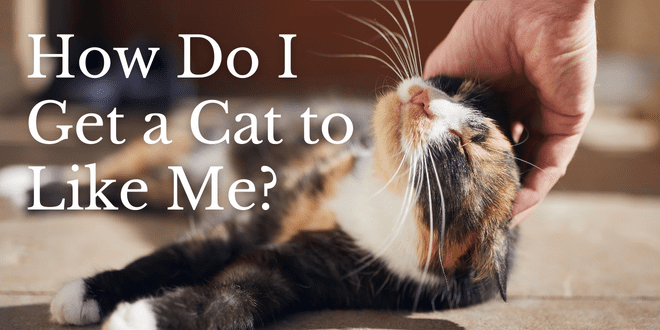
If you haven’t spent much time around cats, you may have the impression they’re aloof or unapproachable. Perhaps you’ve always considered yourself a “dog person” and find it hard to figure out why cats don’t respond in the same way as your favorite canine. Maybe this is your first cat and you’re trying to make friends but don’t quite know the correct approach. It’s really easy to start the bonding process with a cat but if you’re confused or need some advice, I have some important tips that can make a big difference in successful trust-building.
Allow the Cat to Make the First Move
It may have been your experience with dogs that you could go right up to them and begin petting and interacting. With cats, however (and actually with dogs as well), that’s not the recommended approach. In fact, cat lovers who enthusiastically go right up to an unfamiliar cat and try to immediately touch or interact often end up getting an unwanted response.
Have you ever noticed how often the person who doesn’t even like cats or is allergic to them is the one who gets approached by the cat? The reason is simple. The cats picks up on the body language of that person and sees there’s freedom to come closer to do a scent investigation without the threat of getting handled. Scent is an important means of communication and when the cat has the freedom and ability to do that, it helps him feel more at ease. When it comes to approaching the cat, my advice is to not do it. Let the cat come toward you. Let the cat do a scent investigation undisturbed.
Respect a Cat’s Body Language Cues
Watch what a cat is saying by the body posture. Is the body posture communicating a distance-increasing or distance-decreasing response? Is the cat looking away? That may mean there’s no desire to interact. Look at the positioning of the body, ear position, and eyes. Is the cat communicating interest or giving off signals of concern? When evaluating body language, always take into the consideration the immediate circumstances and environment.
When interacting with a cat, remember the best approach involves consent and choice. Has the cat indicated he consents to interaction? Are you giving the cat the choice of whether to engage or not? Kitty will feel much more relaxed and comfortable if there’s a choice.

Photo: Pam Johnson-Bennett
It’s Impolite to Stare at the Cat
In the animal world, a direct stare can be interpreted as a threat. Avoid staring, and instead, if you do look at the cat, make your glances soft and brief. Don’t ever be tempted to stare back at a cat who is looking at you. Let the cat feel in control and comfortable.
The Cat Version of a Handshake
Cats who are familiar and friendly to each other will often approach and engage in some nose-to-nose sniffing. You can do a version of this by extending your index finger for the cat to sniff. This becomes the human version of a cat nose. Hold your finger out without wiggling it or pushing it toward the cat. Just keep your finger still and let the cat make the decision about whether to step forward and sniff. If kitty does sniff your finger, he’ll let you know whether more interaction is ok or not. The cat may sniff and back away, which means he doesn’t want to engage at this point or he may rub against your finger or walk closer toward you. This is an indication that he’s open for more interaction. Pay attention to body language because it’ll tell you whether the cat is comfortable or if a little more time to assess the situation is needed.
Carry Some Treats with You
If the cat is reluctant to come toward you, gently toss a treat nearby to help associate your presence with good things. Sometimes, bribery is a good thing. You can also offer a treat for any positive interaction with you, no matter how slight.
Pet in a Cat-Friendly Way
When dealing with an unfamiliar cat, stick to only petting briefly and watch the reaction to see if he asks for more. Although each cat is an individual and can have specific petting preferences, it’s usually a good idea to stick to the top or back of the head, along the cheeks or under the chin. Some cats like long strokes down the back but for others, it can be too stimulating. When you don’t yet know a cat’s preference, stick to brief petting around the head and then observe the reaction. It’s always better to leave the cat wanting more affection rather than push beyond tolerance level. When cats engage in allogrooming (mutual grooming), they tend to stick to the head area.
Use Your Voice Carefully
You may have gotten an over-the-top positive reaction by doing a high-pitched squealing tone or talking in a baby voice to a dog but that doesn’t fly with the felines. Keep your voice soft and reassuring. Cats don’t react well to loud sounds so your tone of voice should be similar to what you would use to calm a nervous child.
Play with the Cat
Cats were born to move. They’re predators with incredible stealth and accuracy. A good number of the behavior problems seen in indoor cats are due to boredom and lack of activity. If you’ve spent most of your time around dogs, you know the need for regular playtime, walking and exercise, but cats need regular activity as well.
Being indoors is the safest place for cats but that also means it’s up to the cat parent to ensure there’s adequate stimulation, activity and fun. As predators, cats have a natural need to stalk and pounce. You’re a big part of ensuring successful playtime with a cat. It’s not just about leaving a pile of toys available or tossing a toy at the cat in order for him to fetch. Playtime is about discovery, strategy, precision, and success. For cats that means stalk, pounce, capture, reward. Playtime is just as much mental activity as it is physical activity. When you engage in a play session by using an interactive toy, you get to move the toy like prey so the cat can focus on being a hunter. Interactive playtime is also a wonderful way to strengthen the bond and in the case of a cat you’re trying to get to know, it can help him associate positive experiences with your presence.
An interactive toy is based on a fishing pole design. There are many available that have different types of toy targets at the end so try to match the toy with the cat’s personality. For example, if you’re dealing with a very timid cat, stick to a toy that has a smaller toy at the end.
To trigger the cat’s interest, move the toy away or across the cat’s visual field. Never dangle the toy right in front of his face. Let your cat have the time and space to plan a move. When you move the toy like prey, the natural predator in the cat will take over.
Allow the cat to have several successful captures so the game becomes rewarding and not frustrating. Play with the cat at least a couple of times a day. Give the cat a treat after playtime or time the play session before a meal so you can offer a food reward. That way, the might hunter gets to enjoy the feast after capturing the prey.
When dealing with a cat who isn’t ready to be petted or get too close to you, interactive playtime is a great way to share the space and leave the cat feeling more confident about trusting you. As you play, keep in mind where the cat’s comfort zone is in terms of distance.
Handle Negative Reactions the Right Way
If the cat hisses, growls, swats, or even bites, it’s an indication that he feels threatened. If any of this happens, it’s probably because you may have moved too fast or gotten too close. A negative reaction is a clear sign the cat isn’t ready to take the next step. All-too-often, well-meaning people don’t pay attention to early warning body language signs from the cat. If you want to build trust and develop a relationship, pay attention to the cat’s body language and know when to back off before it gets to the point where the cat feels the only option left is to show aggression.
Here are a few body language signs that indicate the cat wants you to back off:
Looking away
Moving away
Curling up and wrapping tail tightly to body
Lashing Tail
Twitching ears
Flattened ears
And of course, vocal sounds such as hissing or growling
Set up the Environment for Success
When a cat feels anxious or nervous, he will look for a place to hide. It’s important that you provide options for hiding, whether it’s something as simple as a box placed on its side or an open paper bag. The ability to have a safe hiding place is a valuable coping mechanism and allows the cat to stay in the area and yet remain “invisible” and safe. A hiding place gives the cat the choice of staying put or venturing out, whether just a bit or all the way into the open. Don’t overlook the value of hiding places for cats. Remember, it all comes down to offering choice. The more choice the cat has, the more comfortable he will feel.
Elevation is another important feature when it comes to creating a cat-friendly environment. Cats feel safe when they can be up high. Elevation gives the cat more of a visual advantage in order to oversee the area and watch out for potential threats. Being up high also decrease the chances of getting ambushed.
If you’re trying to bond with an indoor cat, increase the environmental enrichment. Provide opportunities for fun and distraction. In addition to the interactive play sessions, offer toys for solo play sessions. Include food-dispensing toys as well so the cat gets a reward when he engages in play. Don’t forget the importance of scratching as well. Make sure there’s a tall, sturdy scratching post nearby so the cat has a convenient place to scratch and stretch. Some cats like to scratch horizontally so you can provide a horizontal corrugated cardboard scratching pad.
Food and water bowls, bedding and litter boxes should be convenient and located in areas where the cat feels safe. The cat needs to know there’s no reason to feel threatened or nervous when eating, trying to nap, or using the litter box.
Don’t Rush Things
This is a hard one because it’s normal to desperately want the cat to like you. It’s worth the wait though, so take it slow and remember to let the cat set the pace. Always end each session on a positive note. Gradually build on each session as the cat’s comfort level increases. If you experience a set-back, then go back a few steps and allow the cat to get comfortable again. It will all be worth it as you begin to see little signs indicating that trust is beginning to blossom. Bottom line: allow the cat to have the choice of how much interaction is wanted. Let the cat set the pace and you’ll be well on your way to developing a wonderful relationship.
Need More Information?
For more specific information on cat behavior and training, refer to the books by best-selling author Pam Johnson-Bennett. Pam’s books are available at bookstores and online. We’ve included Amazon links on our website.

